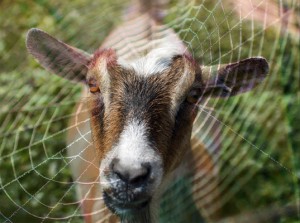Spider Goats and the Future of Synthetic Biology
Science is doing some crazy things in the world of genetics these days. Have you heard about the half goat, half spider?
Dragline silk, produced by spiders and used to catch them when they fall, is incomprehensibly strong for it’s weight. It’s stronger than kevlar used in bullet-proof vests. The possible uses are endless. The thing is, spiders are tough to gather and ‘farm for their silk.’ They produce a miniscule amount of this fiber, so we’re unable to harvest it to study and use.
That’s where the goats come into play. Using a form of DNA adjustment called synthetic biology, scientists have taken the gene associated with the production of dragline silk in spiders, and mixed it into the DNA that promotes milk production in goats. They can now obtain drastically more silk in a more controlled manner. Scientists are referring to this technique as advanced farming.
Although the concept is zany, don’t expect to see these spider-goats spinning webs and capturing insects at a farm near you. They look and act identical to a regular goat. When you milk them, the milk is exactly the same as regular goat’s milk except for one additional protein. This protein can be extracted as the highly desirable dragline silk.
This spider silk has some amazing real world properties. It’s elasticity and strength allow doctors insert it into humans to replace torn ligaments. No longer well we have to wait on a cadaver or painfully extract a piece of our hamstring. In limited studies, most humans have shown to react very well to this silk.
The broader take away here is that in the 21st century, we’ve become experts at the DNA code. We can essentially cut and paste certain parts together to create what we want. This technology has the potential to help us get to the root cause of cancer, and diseases passed through genetics. Scientists are forming a genetic registry containing the codes of every creature on the planet. This registry will enable us to create new life forms from scratch. Sounds a little like Jurassic Park, pretty fascinating in some ways, buy pretty scary when mishandled.
In 2010, U.S. geneticist Craig Venter used synthetic biology to create the world’s first synthetic life form. Of this achievement, Oxford Professor Julian Savulescu said: “we are going towards the role of a god: creating artificial life that could never have existed naturally.”
Now, organisms are being created to soak up carbon dioxide and other undesirable gases from the atmosphere. Synthetic organisms are being made to secrete medicine that can instantly be administered to patients. Finally, there are companies designing synthetic organisms that can produce diesel fuel. Synthetic biology is definitely a game changer. Can you imagine the future applications and possibilities?
It seems like more and more stories of humans playing God continue to pop-up everyday. How do you feel about synthetic biology? What other areas of life could potentially be improved. What hybrid creations can you think of, and what would their purpose be? Let us know below!
Comments
Tags: advanced farming, biosteel, craig venter, dragline silk, genetic registry, julian savulescu, playing God?, synthetic biology
Trackback from your site.


Comments (1)
Dennis Krieger
| #
…and they’re easier to milk than spiders!
Reply